fuel PONTIAC PONTIAC 1995 Owners Manual
[x] Cancel search | Manufacturer: PONTIAC, Model Year: 1995, Model line: PONTIAC, Model: PONTIAC PONTIAC 1995Pages: 354, PDF Size: 17.27 MB
Page 6 of 354
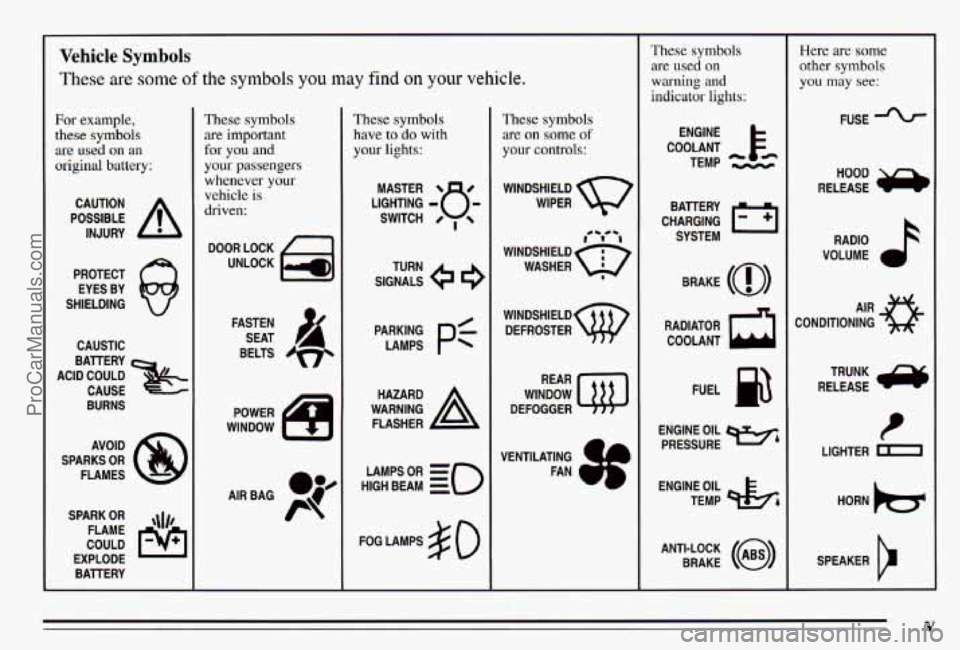
Vehicle Symbols
These are some of the symbols you may find on your vehicle.
For example,
these symbols
are used on an
original battery;
POSSIBLE A
CAUTION
INJURY
PROTECT EYES BY
SHIELDING
CAUSTIC
ACID COULD BATTERY
CAUSE
BURNS
AVOID
SPARKS
OR
FLAMES
SPARK
OR ,\I/,
COULD FLAME
EXPLODE BATTERY
These symbols
are important
for
you and
your passengers
whenever your
vehicle is
driven:
DOOR LOCK
UNLOCK
FASTEN SEAT
BELTS
S
These symbols
have to
do with
your lights:
SIGNALS e
TURN
HIGH
LAMPSoR BEAM = =o
FOG LAMPS $0
These symbols
are
011 some of
your controls:
WINDSHIELD WIPER
WINDSHIELD DEFROSTER
WINDOW
DEFOGGER
VENTILATING
a+
FAN w*
These symbols
are used
on
warning and
indicator lights:
COOLANT F-
ENGINE
TEMP
- k
CHARGING BATTERY
SYSTEM
BRAKE
(0)
RADIATOR COOLANT
a
FUEL
ENGINE OIL
PRESSURE
Wb
TEMP OIL &
ANTI-LOCK (@)
BRAKE
Here are some
other symbols
you may see:
FUSE
RELEASE RADIO
k
VOLUME a
CONDITIONING AIR 33
RELEASE TRUNK ru
t
LIGHTER m
SPEAKER
b
V
ProCarManuals.com
Page 72 of 354
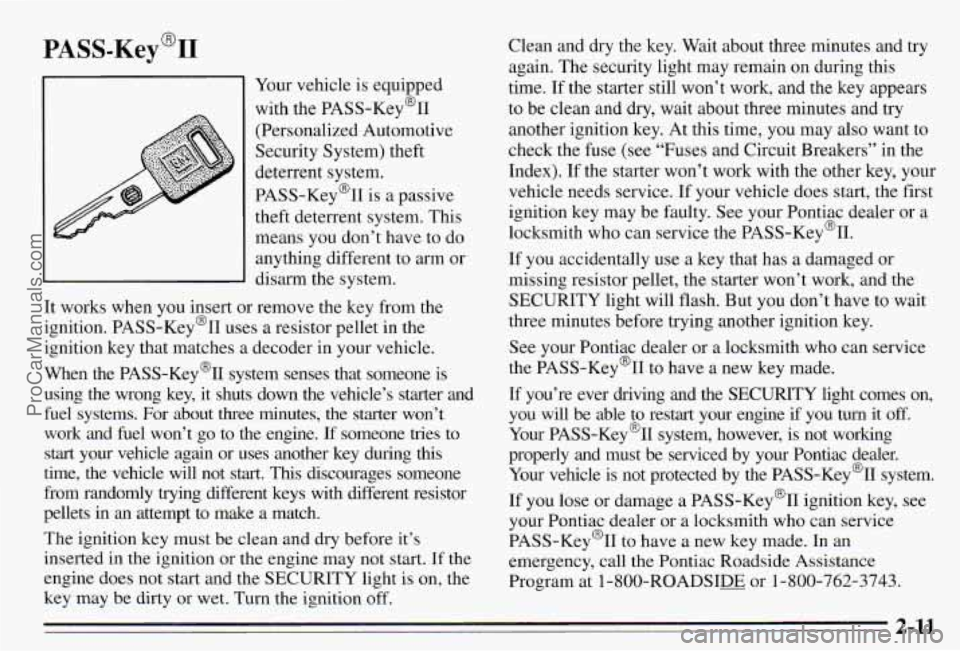
Your vehicle is equipped
with the PASS-Key@II (Personalized Automotive
Security System) theft
deterrent system.
PASS-Key@II is a passive
theft deterrent system. This
means you don’t have to do
anything different to arm or
disarm
the system.
It works when you insert
or remove the key from the
ignition. PASS-Key@II uses a resistor pellet in the
ignition key that matches a decoder in your vehicle.
When the PASS-Key@II system senses that someone is
using the wrong key, it shuts down the vehicle’s starter an\
d
fuel systems. For about three minutes, the starter won’t
work and fuel won’t go
to the engine. If someone tries to
start your vehicle again or uses another key during this
time, the vehicle will not start. This discourages someone
from randomly trying different keys with different resistor
pellets in an attempt to make a match.
The ignition key must be clean and dry before it’s
inserted in the ignition or the engine may not start. If
the
engine does not start and the SECURITY light is on, the
key may be dirty or wet. Turn the ignition off. Clean and dry the key. Wait about
three minutes and try
again. The security light may remain on during this
time. If the starter still won’t work, and the key appears
to be clean and dry, wait about three minutes and try
another ignition key. At this time, you may also want to
check the fuse (see “Fuses and Circuit Breakers” in the
Index). If the starter won’t work with the other key, your
vehicle needs service. If your vehicle does start, the first
ignition key may be faulty. See your Pontiac dealer or a
locksmith who can service the PASS-Key@II.
If you accidentally use a key that has a damaged or
missing resistor pellet, the starter won’t work, and the
SECURITY light will flash. But you don’t have to wait
three minutes before trying another ignition key.
See your Pontiac dealer or a locksmith who can service
the PASS-Key@II to have a new key made.
If you’re ever driving and the SECURITY light comes on,
you will
be able to restart your engine if you turn it off.
Your PASS-Key% system, however, is not working
properly
and must be serviced by your Pontiac dealer.
Your vehicle is not protected by the PASS-Key% system.
If you lose or damage a PASS-Key@II ignition key, see
your Pontiac dealer or a locksmith who can service
PASS-Key@II
to have a new key made. In an
emergency, call the Pontiac Roadside Assistance
Program at 1-800-ROADSIB or
1-800-762-3743.
2-11
ProCarManuals.com
Page 75 of 354
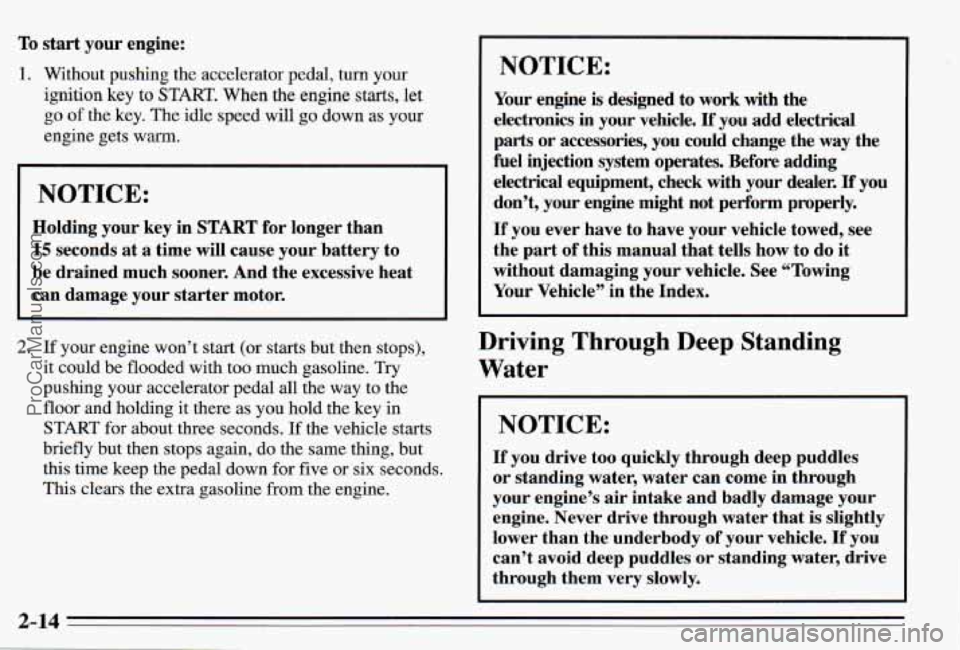
To start your engine:
1. Without pushing the accelerator pedal, turn your
ignition
key to START. When the engine starts, let
go of the key. The idle speed will
go down as your
engine gets warm.
NOTICE:
Holding your key in START for longer than
15 seconds at a time will cause your battery to
be drained much sooner. And the excessive heat
can damage your starter motor.
2. If your engine won’t start (or starts but then stops),
it could be flooded with too much gasoline. Try
pushing your accelerator pedal all the way to the
floor and holding it there as you hold the key in
START for about three seconds. If the vehicle starts
briefly but then stops again, do the same thing, but
this time keep the pedal down for five or six seconds.
This clears the extra gasoline from the engine. Your
engine
is designed to work with the
electronics
in your vehicle. If’ you add electrical
parts or accessories, you could change the way the
fuel injection system operates. Before adding
electrical equipment, check with your dealer.
If you
don’t, your engine might not perform properly.
If you ever have to have your vehicle towed, see
the part of this manual that tells how to do it
Driving Through Deep Standing
Water
NOTICE:
If you drive too quickly through deep puddles
or standing water, water can come
in through
your engine’s
air intake and badly damage your
engine. Never drive through water that is slightly
lower than the underbody
of your vehicle. If you
can’t avoid deep puddles or standing water, drive
through them very slowly.
2-14
ProCarManuals.com
Page 76 of 354

Engine Coolant Heater (Option)
In very cold weather, 0 OF (- 1 8 O C) or colder, the engine
coolant heater can help. You’ll get easier starting and
better
fuel economy during engine warm-up. Usually,
the coolant heater should be plugged
in a minimum of
four hours prior to starting your vehicle.
To use the coolant heater:
1. Turn off the engine.
2. Open the hood and unwrap the electrical cord.
3. Plug it into a normal, grounded 1 10-volt outlet.
NOTICE:
After you’ve used the coolant heater, be sure to
store the cord as it was before to keep it away
from moving engine parts. If you don’t, it could
be damaged.
How long should you keep the coolant heater plugged
in? The answer depends on the weather, the kind
of oil
you have, and some other things. Instead
of trying to list
everything here, we
ask that you contact your Pontiac
dealer in the area where you’ll
be parking your vehicle.
The dealer can give
you the best advice for that
particular area.
2-15
ProCarManuals.com
Page 80 of 354
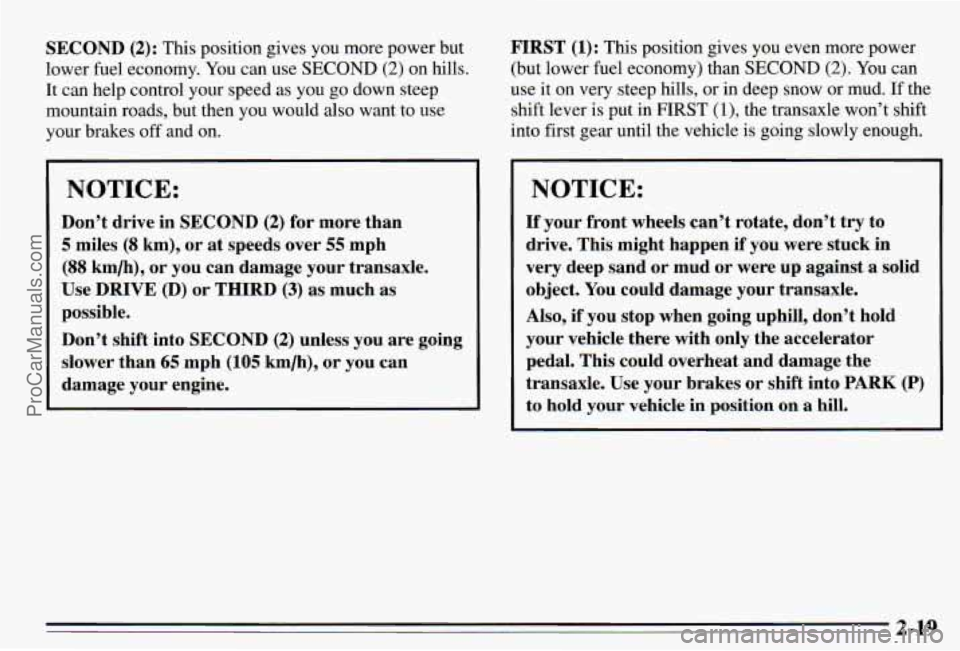
SECOND (2): This position gives you more power but
lower fuel economy. You can use
SECOND (2) on hills.
It can help control your speed as you go down steep
mountain roads, but then you would also want to use
your brakes off and
on.
NOTICE:
Don’t drive in SECOND (2) for more than
5 miles (8 km), or at speeds over 55 mph
(88 km/h), or you can damage your transaxle.
Use DRIVE
(D) or THIRD (3) as much as
possible.
Don’t shift into
SECOND (2) unless you are going
slower than
65 mph (105 km/h), or you can
damage your engine. FIRST
(1): This position gives you even more power
(but lower fuel economy) than
SECOND (2). You can
use it on very steep hills, or in deep snow or mud.
If the
shift lever is put in FIRST
(l), the transaxle won’t shift
into first gear until the vehicle is going slowly enough.
NOTICE:
If your front wheels can’t rotate, don’t try to
drive. This might happen
if you were stuck in
very deep
sand or mud or were up against a solid
object. You could damage your transaxle.
Also,
if you stop when going uphill, don’t hold
your vehicle there with only the accelerator
pedal. This could overheat and damage the
transaxle. Use your brakes or shift into PARK
(P)
to hold your vehicle in position on a hill.
2-19
ProCarManuals.com
Page 107 of 354

Instrument Panel -- Your Information System
3.1L United States Version Shown, Others Similar
Your instrument cluster is designed to let you know at a glance how your vehicle is running. You’ll know how fast
you’re going, about how much fuel
is in your tank and many other things you need to drive safely and economically.
2-46
ProCarManuals.com
Page 110 of 354
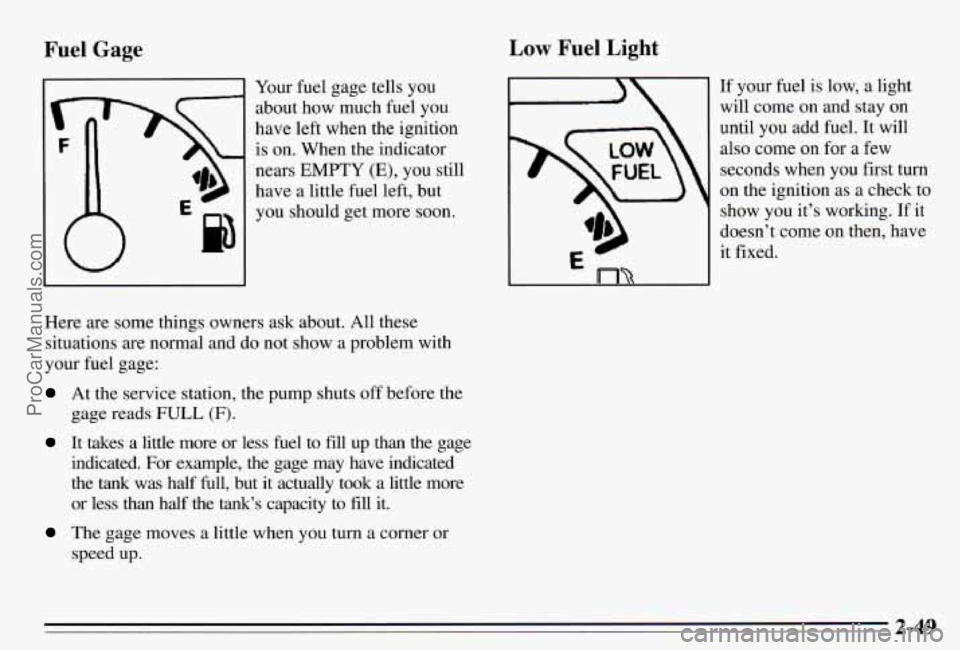
Fuel Gage Low Fuel Light
Your
fuel gage tells you
about how much fuel you
have left when the ignition
is on. When the indicator
nears
EMPTY (E), you still
have a little fuel left, but
you should get more soon.
Here are some things owners ask about. All these
situations are normal and
do not show a problem with
your fuel gage:
At the service station, the pump shuts off before the
gage
reads FULL (F).
It takes a little more or less fuel to fill up than the gage
indicated. For example, the gage may have indicated
the tank was half
full, but it actually took a little more
or less than half the tank’s capacity to fill it.
The gage moves a little when you turn a corner or
speed up. If
your fuel is low, a light
will come on and stay
on
until you add fuel. It will
also come on for
a few
seconds when you first turn
on the ignition as a check
to
show you it’s working. If it
doesn’t come on then, have
it fixed.
2-49
ProCarManuals.com
Page 117 of 354

Malfunction Indicator Lamp
(Service Engine Soon Light)
A computer monitors
operation
of your fuel,
ignition and emission
control systems. This light should come on when the
ignition is on, but the
engine is not running,
as a
check to show you it is
working.
If it does not come on at all, have it fixed right away. If
it stays on, or it comes on while you are driving, the
computer is indicating that you have a problem. You
should take your vehicle in
for service soon.
NOTICE:
If you keep driving your vehicle with this light
on, after a while the emission controls won’t
work as well, your fuel economy won’t be as good
and your engine may not run as smoothly. This
could lead
to costly repairs not covered by your
warranty.
2-56
ProCarManuals.com
Page 120 of 354
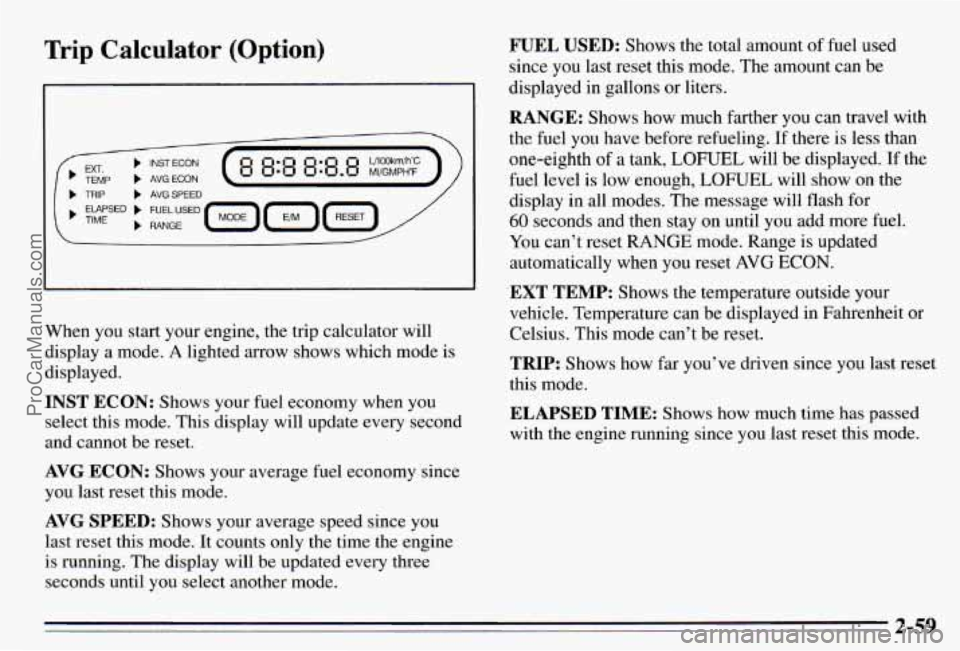
Trip Calculator (Option)
L
When you start your engine, the trip calculator will
display a mode.
A lighted arrow shows which mode is
displayed.
INST ECON: Shows your fuel economy when you
select
this mode. This display will update every second
and cannot be reset.
AVG ECON: Shows your average fuel economy since
you last reset this mode.
AVG SPEED: Shows your average speed since you
last reset this mode.
It counts only the time the engine
is running.
The disp1.a~ will be updated every three
seconds until you select another mode.
WEL USED: Shows the total amount of fuel used
since you last reset
this mode. The amount can be
displayed in gallons or liters.
RANGE: Shows how much farther you can travel with
the
fuel you have before refueling. If there is less than
one-eighth
of a tank, LOF’UEL will be displayed. If the
fuel level is
low enough, LOFUEL will show on the
display in all modes. The message
will flash for
60 seconds and then stay on until you add more fuel.
You can’t reset
RANGE mode. Range is updated
automatically when you reset
AVG ECON.
‘EXT TEMP: Shows the temperature outside your
vehicle. Temperature can be displayed in Fahrenheit or
Celsius. This mode can’t be reset.
TRIP: Shows how far you’ve driven since you last reset
this mode.
ELAPSED TIME: Shows how much time has passed
with the engine running since you last reset this mode.
2-59
ProCarManuals.com
Page 121 of 354
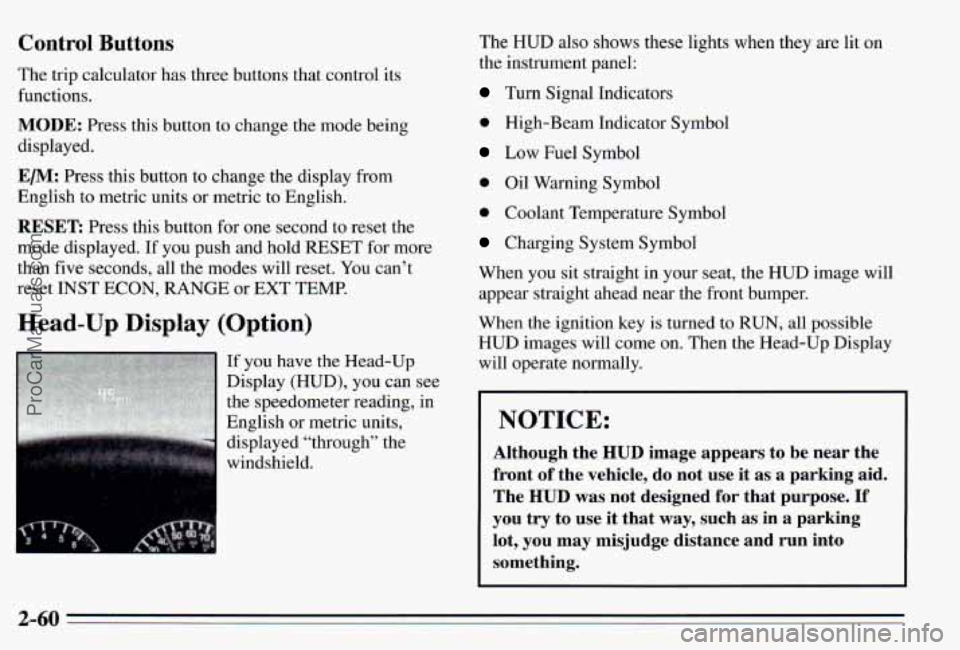
Control Buttons
The trip calculator has three buttons that control its
functions.
MODE: Press this button to change the mode being
displayed.
EM: Press this button to change the display from
English to metric units or metric to English.
RESET Press this button for one second to reset the
mode displayed.
If you push and hold RESET for more
than five seconds, all the modes will reset. You can’t
reset
INST ECON, RANGE or EXT TEMP.
Head-Up Display (Option)
If you have the Head-Up
Display (HUD), you can see
the speedometer reading, in
English or metric units,
displayed “through” the
windshield. The
HUD also shows these lights when they are
lit on
the instrument panel:
Turn Signal Indicators
0 High-Beam Indicator Symbol
Low Fuel Symbol
0 Oil Warning Symbol
0 Coolant Temperature Symbol
Charging System Symbol
When you sit straight in your seat, the HUD image will appear straight ahead near the front bumper.
When the ignition key is turned
to RUN, all possible
HUD images will come on. Then the Head-Up Display
will operate normally.
NOTICE:
Although the HUD image appears to be near the
front
of the vehicle, do not use it as a parking aid.
The
HUD was not designed for that purpose. If
you try to use it that way, such as in a parking
lot, you may misjudge distance and run into
something.
2-60
ProCarManuals.com